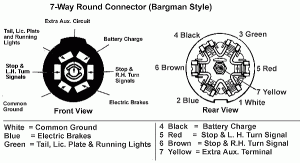Electrical, Tow Lighting
Q: I have an early 1960’s trailer. Do you have a schematic of the wiring on this trailer?
A: There were no owners manuals until 1964, that is where this information would normally be. Since a schematic is critical to restoring and maintaining your Airstream, it is a good idea to create one, mapping out your wiring and understanding where everything goes. A Test Light and a few alligator clip pig-tails will help.
Q: Where can I get replacement Marker Lights?
A: A cheap looking replacement for the Bargman teardrop style is made, and the 1960’s oval and 1970’s “double bullseye” lights are still being manufactured by the original manufacturer Grote. All 3 can be purchased at Vintage Trailer Supply.
Q: I have an old trailer in which the clearance lights and taillights don’t work and no schematic. How can I track this down?
A: Schematics weren’t published until 1964. However, the following general suggestions have proven helpful in the past:
- In trailers of this age, the wires coming from the tow car pass down the tongue via a pigtail to a junction point above the belly pan a few inches in back of the front of the body shell. There is an inspection cover in the belly pan at this point. From this point, the wires run back to taillights and over to the Marker Lights and the brakes if equipped. At, or near this point is a ground to the trailer shell. A faulty ground shows up as no lights working when the trailer is unhitched. Make sure this ground connection is OK.
In the 1950 era trailers , the junction point was inside the wall just above where the harness wire goes in to the belly skin. - In checking circuit continuity, use a light bulb, not an ohm or voltmeter. The reason: A fragile (high resistance) circuit may appear good by the meter, but it is not good enough to light a bulb.
- Bulbs often are corroded into the sockets. Use WD-40, or crush and replace the bulbs. Clean all contact surfaces. Replacement bayonet sockets are available from RV Dealers.
- All grounds to the trailer shell are suspect. Wire in new ones frequently. You can’t have too many. The rivets that hold the Marker Light bases in place are suspect, as they are used for the ground. Replace these or install short jumper wires.
Q: Where can I get replacement lenses for the Bargman 99 “Wedding Cake” taillights?
A: Reproductions are available from Vintage Trailer Supply.
Q: I think my older original recessed Bargman “9” taillights (#11 lenses) are wired for 6 volts still. What can I do?
A: These were originally 6 volt lights with independent turn and stop elements in addition to the tail (running) light. The easiest fix is to replace the socket pigtail with a single contact type and replace the bulbs with 12 volt equivalents. Cap off the unused circuit for the old brake light circuit.
Q: Someone dealt with the 6 volt issue by replacing the Bargman 9’s with cheap replacements. What can I do?
A: Signal-Stat makes a similar recessed truck light with a chrome ring that looks pretty close. The part number is #3612. Grote has one too, #52522.
Q: My Bargman 9’s are still there but are in bad shape, are lenses and the rings still available?
A: Once again Vintage Trailer Supply comes through with replacements. The rings aren’t cheap though, but are made out of non-rusting aluminum. Your existing rings can be chrome plated by any custom-rod shop for about $30.
Q: My flush mounted porch light is melted looking. What can I do?
A: This is also called a “scare” light for some reason (used to scare intruders away?). It is really just a back-up light made by Signal-Stat, and if left on for real long periods of time, the lens will melt. Replacement lenses and lights are still available from Signal-Stat and and Vintage Trailer Supply.
Q: My rear license plate holder and light is rusted out. Where can I get one?
A: The one used from 1958 to 1968 was made by Signal-Stat (part # 435W), and is still available from truck/trailer part stores and Vintage Trailer Supply. They also have the 1970’s version too.
Q: Our 1948 Liner has just a single taillight in the middle. Is this legal?
A: It used to be until the early 1950’s, when federal laws were passed requiring turn indicators. This early single light was called the “Universal Night Owl” and contained a stoplight, taillight with license plate illumination. The early retrofit for these trailers was the use of “Yankee Turnmaster” lights, added to the outboard corners of the rear. Conventional all in one lights started appearing in 1951-1952. The older trailers were grand-fathered, but even they too were required to have lights installed. This may mean your trailer hasn’t been licensed or used in decades!
Q: How are AIrstream electrical hitch plugs wired up?
A: If you have an older Airstream, they may be wired different than the 7pin standard of today, even though it may be the same connector. Best bet is change the wires around to match the following, so that you can use another tow vehicle if necessary or in emergencies.

Tow vehicle receptacle shown. Mirror reverse (flip left and right) for the trailer plug layout.
Electrical, 110/12 Volt Wiring
Q: Were Airstreams made with aluminum wire? Must it all replaced?
A: As a result of copper shortage during the Vietnam War years of between 1966 and 1968, Airstream used aluminum for some of the primary 1110v wiring. It seems it was based on copper Romex wire availability, and as such not all trailers during that period used aluminum Romex. One cannot connect aluminum wire to devices or connectors that are not rated for AL-CU usage, such as the circuit breakers and outlets and switches. Where the aluminum and copper parts touch together a chemical reaction occurs which forms an insulating layer between the two, not at all what you want in an electrical circuit. You have choices:
- You can arrange that only copper wire ties into these CU only rated parts. You can do this by interposing short pieces of copper wire at the box, making the copper to aluminum connection (wire to wire) a short distance away using a special type of bimetallic connector lug and gel compound made for this purpose.
- You can remove the inner skins and replace all the wiring with copper.
- Or you can replace the circuit breakers, connectors, switches and outlets with those rated AL-CU and use the dielectric compound. You still must make the connectors to pigtail components such as motors and some lamps with the special connectors. Ask an electrical supply house or electrician for help on something as important as this.
Q: What is a Uni-volt?
A: A Uni-Volt is a brand-name for a power converter system used by Airstream. The system was first used about 1964, and is used to provide 12 volt DC power and 18 volt AC power to the trailer from 100v shore power. Being a ferroresonant converter, it will hum. Some people turn theirs off at night. It is basically a power reduction transformer, AC to DC rectifier with filter capacitors. The 12VDC volts is used to supply the light fixtures and the 18VAC for the fan motors. When not connected to shore power, the trailer battery is used to supply 12VDC to these users.
The 12VDC went to the lights and the 18VAC went to the vent and pump motors. A 12 volt light bulb works equally well on 12 volts DC or AC. But a 12 VDC motor, if used on AC must have 18 volts supplied to it to function correctly because the effective DC voltage of 18VAC is 12.7 volts.
Q: How do I determine if my Uni-volt converter is working?
A: With the Uni-volt off, measure the voltage at the battery. It should be 13.8V +/- 1V. Turn the converter on – the measured voltage should increase by about 0.5V.
The only part that routinely goes bad is the capacitor. Usually is 25 uFd at 600 volt AC. You should be able to get one at a motor rewind shop or maybe an air conditioner repair place.
Q: Does the Uni-volt charge the trailer battery when connected to shore power?
A: The first Uni-volt systems introduced in 1964 did not, it was not until later when they added a regulated charging circuit that they did – and even then only on the larger trailers. On the other trailers, the tow-vehicle charging system is the only source of re-charge.
Q: I’m picking up an old Airstream that has an electrical plug with round terminals. Are the old Airstreams wired different?
A: Yes, but most have been converted over to the newer connectors and wiring layout. If by chance it hasn’t, you can convert it to the current standard as shown on this Marks RV info page.
Q: My trailer has this aluminum box on the front that looks like it was for a battery, but a battery won’t fit into it. What is it?
A: It’s for a tractor battery, still available at farm supply stores or battery places such as Interstate and Batteries Plus. If you want to use the box mounted on the front of the trailer, you have no choice other than to use that type. The type is a 3ET. Capacity is 600 Cold Cranking amps, which compares favorably to modern 12V deepcycle batteries, but is a little more expensive. To use a modern battery, options include mounting a new battery storage box on the tongue spicing in a new lead down to it, and using the old box as storage. Try to get the aluminum style boxes (hot-rod accessory), as the plastic ones fail from UV exposure (straps & latches). Mounting the battery under the bed next to an access door requires a little more work as it involves tie downs and venting the battery to the outside.








